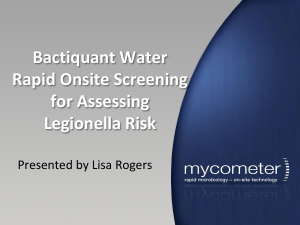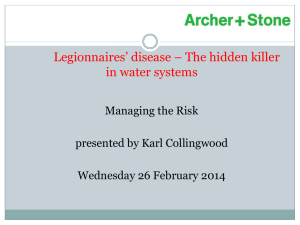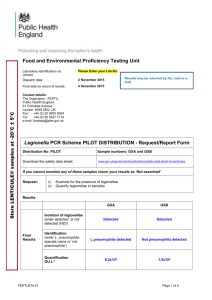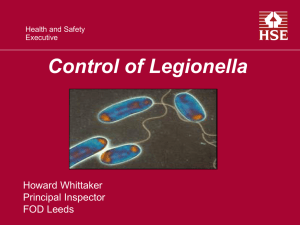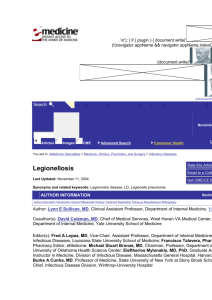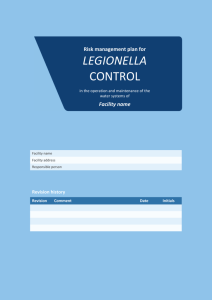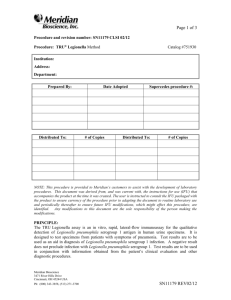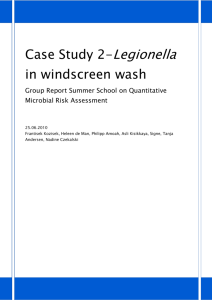Quantification of Legionella spp
advertisement
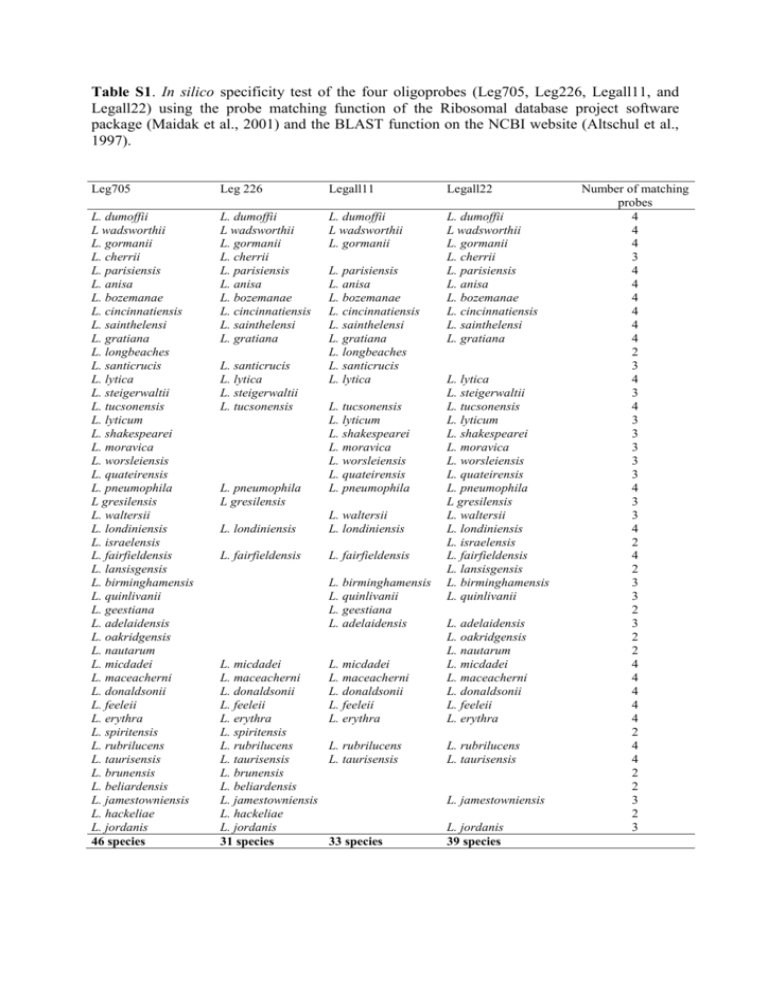
Table S1. In silico specificity test of the four oligoprobes (Leg705, Leg226, Legall11, and Legall22) using the probe matching function of the Ribosomal database project software package (Maidak et al., 2001) and the BLAST function on the NCBI website (Altschul et al., 1997). Leg705 Leg 226 Legall11 Legall22 L. dumoffii L wadsworthii L. gormanii L. cherrii L. parisiensis L. anisa L. bozemanae L. cincinnatiensis L. sainthelensi L. gratiana L. longbeaches L. santicrucis L. lytica L. steigerwaltii L. tucsonensis L. lyticum L. shakespearei L. moravica L. worsleiensis L. quateirensis L. pneumophila L gresilensis L. waltersii L. londiniensis L. israelensis L. fairfieldensis L. lansisgensis L. birminghamensis L. quinlivanii L. geestiana L. adelaidensis L. oakridgensis L. nautarum L. micdadei L. maceacherni L. donaldsonii L. feeleii L. erythra L. spiritensis L. rubrilucens L. taurisensis L. brunensis L. beliardensis L. jamestowniensis L. hackeliae L. jordanis 46 species L. dumoffii L wadsworthii L. gormanii L. cherrii L. parisiensis L. anisa L. bozemanae L. cincinnatiensis L. sainthelensi L. gratiana L. dumoffii L wadsworthii L. gormanii L. dumoffii L wadsworthii L. gormanii L. cherrii L. parisiensis L. anisa L. bozemanae L. cincinnatiensis L. sainthelensi L. gratiana L. santicrucis L. lytica L. steigerwaltii L. tucsonensis L. pneumophila L gresilensis L. parisiensis L. anisa L. bozemanae L. cincinnatiensis L. sainthelensi L. gratiana L. longbeaches L. santicrucis L. lytica L. tucsonensis L. lyticum L. shakespearei L. moravica L. worsleiensis L. quateirensis L. pneumophila L. londiniensis L. waltersii L. londiniensis L. fairfieldensis L. fairfieldensis L. birminghamensis L. quinlivanii L. geestiana L. adelaidensis L. micdadei L. maceacherni L. donaldsonii L. feeleii L. erythra L. spiritensis L. rubrilucens L. taurisensis L. brunensis L. beliardensis L. jamestowniensis L. hackeliae L. jordanis 31 species L. lytica L. steigerwaltii L. tucsonensis L. lyticum L. shakespearei L. moravica L. worsleiensis L. quateirensis L. pneumophila L gresilensis L. waltersii L. londiniensis L. israelensis L. fairfieldensis L. lansisgensis L. birminghamensis L. quinlivanii L. micdadei L. maceacherni L. donaldsonii L. feeleii L. erythra L. adelaidensis L. oakridgensis L. nautarum L. micdadei L. maceacherni L. donaldsonii L. feeleii L. erythra L. rubrilucens L. taurisensis L. rubrilucens L. taurisensis L. jamestowniensis 33 species L. jordanis 39 species Number of matching probes 4 4 4 3 4 4 4 4 4 4 2 3 4 3 4 3 3 3 3 3 4 3 3 4 2 4 2 3 3 2 3 2 2 4 4 4 4 4 2 4 4 2 2 3 2 3 A B C D E F Figure S1. Examples of epifluorescent micrographs of hybridized cultured Legionella cells obtained using the fluorescent in situ hybridization method. (A) L. longbeaches CIP 103881 matching with 2 probes; (B) L. jordanis CIP 105268 matching with 3 probes, and strains matching with the set of 4 probes; (C) L. anisa ATCC 35292; (D) L. pneumophila sg1 ATCC 4370; (E) L. pneumophila sg15 ATCC 32251; (F) L. sainthelensi CIP 103885. Method S1 Quantitative performances of the assay performed for 24h of cultivation time The quantitative performance of the method for enumerating microcolonies of Legionella from cooling tower water samples was evaluated on an artificially contaminated water sample with known log-decimal concentrations of L. pneumophila sg 1 to define the linearity domain, and the detection limit of the method. The water sample was analyzed prior to artificial contamination, and showed an absence of Legionella (equivalent to < 200 Legionella MicFU l-1). The quantification was performed on five replicates with a cell density level ranging from 102 to 107 viable cells added. The microcolonies were enumerated by SPC after 24 h at 30°C. The theoretical counts and the Legionella MicFU counts were linearly correlated with the number of L. pneumophila cells added as the inoculums in a loglog plot for both cultivation times (n = 20, r = 0.656, P = 0.002; Spearman test). Twenty out 30 water samples (66.7%) were positive using the approach for 24 h. For this shorter incubation time, no microcolony was detected for the theoretical cells added at 380 cells l-1, and MicFUs were detected in 2 replicates of the 5 analyzed for theoretical cells added at 3800 cells l-1. Consequently, we estimated the linearity domain of the trial method to range between 104 and 107 MicFU l-1 for the shorter incubation time (24 h). Enumerations were performed by SPC after 24 h of incubation at 30°C on GVPC. The concentration of Legionella spp. measured by the standard culture method was 2.5 104 CFUs per liter. The mean concentrations were 1.3 103 and 2.1 104 Legionella MicFUs per liter after 24 h of cultivation. The repeatability of the trial method was investigated by determining the coefficient of variation (CV) measured from the number of microcolonies detected by SPC from each water sample. The CV was 44.5% for enumeration performed after 24 h of cultivation. 2 Legionella spp. quantification in naturally contaminated cooling tower water samples by MicFU-FISH-SPC after 24h of cultivation and comparison with standard plate counts. The microcolonies of Legionella were enumerated from all the water samples following application of the physical and chemical treatments described previously, and following cultivation performed for 24 h at 30°C on GVPC agar. About 80% of the water samples were positive using the standard culture method (Table A). Legionella CFU concentrations ranged between 5.102 and 8.5 105 CFU l-1. In contrast, 62.7 % of the water samples were positive using the trial method for Legionella enumerated after 24 h. The MicFU concentrations ranged between 6.102 and 3.2 105 MicFU l-1. The percentage of water samples for which the results of the two methods are in agreement (MicFU+/CFU+ and MicFU-/CFU- pair results) was 81% (n = 176) for cultivation of microcolonies performed for 24 h. If the results were not in agreement, this was mainly due to the MicFU-/CFU+ pair result for 24 h of cultivation. Table A. Comparison of the number of sample (percentage in parentheses) positive or negative with MicFU-FISH-SPC (MicFU) assay performed for 24 h of incubation time and the standard culture method (CFU) for detecting Legionella spp. in 217 cooling tower water samples. MicFU Total + - + 135 (62.2) 40 (18,4) 175 - 1 (0.5) 41 (18,9) 42 136 81 217 CFU total In total, 217 water samples were analyzed with both methods. The MicFU counts were linearly correlated in a log-log plot, as reported in Figure B (P<0.0001; Pearson test). The counts enumerated after 48 h were significantly higher than those measured for the shorter cultivation time (Wilcoxon signed rank test, P<0.0001 for α=5%). 3 MicFU for 48h [log10 (MicFU+1) l-1] 7 6 5 4 3 y = 0.6786x + 1.9996 r² = 0.5125 n = 217 2 1 0 0 1 2 3 4 5 MicFU for 24h [log10 (MicFU+1) l-1] 6 7 Figure B. Relationship between MicFU counts of Legionella measured after 24 h and 48 h on GVPC at 30°C. The MicFU measured after 24h of cultivation and CFU counts were linearly correlated (Pearson test, P<0.0001 for α=5%) (Figure C). MicFU for 24h [log10 (MicFU+1) l-1] 7 6 y = 0.7232x - 0.2535 r² = 0.5029 n = 217 5 4 3 2 1 0 0 1 2 3 4 5 Standard plate count [log10 (CFU+1) l-1] 6 7 Figure C. Relationship between Legionella counts measured from naturally contaminated cooling tower water samples by the standard method and the trial method after: (A) 24 h; and (B) 48 h of cultivation on GVPC at 30°C. 4

